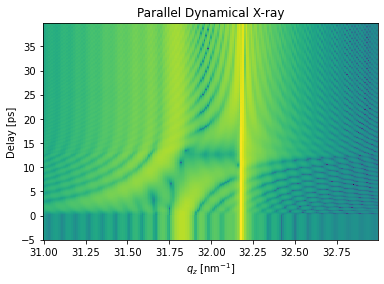Dynamical X-ray Scattering#
In this example static and transient X-ray simulations are carried out employing the dynamical X-ray scattering formalism.
Setup#
Do all necessary imports and settings.
import udkm1Dsim as ud
u = ud.u # import the pint unit registry from udkm1Dsim
import scipy.constants as constants
import numpy as np
import matplotlib.pyplot as plt
%matplotlib inline
u.setup_matplotlib() # use matplotlib with pint units
Structure#
Refer to the structure-example for more details.
O = ud.Atom('O')
Ti = ud.Atom('Ti')
Sr = ud.Atom('Sr')
Ru = ud.Atom('Ru')
Pb = ud.Atom('Pb')
Zr = ud.Atom('Zr')
# c-axis lattice constants of the two layers
c_STO_sub = 3.905*u.angstrom
c_SRO = 3.94897*u.angstrom
# sound velocities [nm/ps] of the two layers
sv_SRO = 6.312*u.nm/u.ps
sv_STO = 7.800*u.nm/u.ps
# SRO layer
prop_SRO = {}
prop_SRO['a_axis'] = c_STO_sub # aAxis
prop_SRO['b_axis'] = c_STO_sub # bAxis
prop_SRO['deb_Wal_Fac'] = 0 # Debye-Waller factor
prop_SRO['sound_vel'] = sv_SRO # sound velocity
prop_SRO['opt_ref_index'] = 2.44+4.32j
prop_SRO['therm_cond'] = 5.72*u.W/(u.m*u.K) # heat conductivity
prop_SRO['lin_therm_exp'] = 1.03e-5 # linear thermal expansion
prop_SRO['heat_capacity'] = '455.2 + 0.112*T - 2.1935e6/T**2' # [J/kg K]
SRO = ud.UnitCell('SRO', 'Strontium Ruthenate', c_SRO, **prop_SRO)
SRO.add_atom(O, 0)
SRO.add_atom(Sr, 0)
SRO.add_atom(O, 0.5)
SRO.add_atom(O, 0.5)
SRO.add_atom(Ru, 0.5)
# STO substrate
prop_STO_sub = {}
prop_STO_sub['a_axis'] = c_STO_sub # aAxis
prop_STO_sub['b_axis'] = c_STO_sub # bAxis
prop_STO_sub['deb_Wal_Fac'] = 0 # Debye-Waller factor
prop_STO_sub['sound_vel'] = sv_STO # sound velocity
prop_STO_sub['opt_ref_index'] = 2.1+0j
prop_STO_sub['therm_cond'] = 12*u.W/(u.m*u.K) # heat conductivity
prop_STO_sub['lin_therm_exp'] = 1e-5 # linear thermal expansion
prop_STO_sub['heat_capacity'] = '733.73 + 0.0248*T - 6.531e6/T**2' # [J/kg K]
STO_sub = ud.UnitCell('STOsub', 'Strontium Titanate Substrate',
c_STO_sub, **prop_STO_sub)
STO_sub.add_atom(O, 0)
STO_sub.add_atom(Sr, 0)
STO_sub.add_atom(O, 0.5)
STO_sub.add_atom(O, 0.5)
STO_sub.add_atom(Ti, 0.5)
S = ud.Structure('Single Layer')
S.add_sub_structure(SRO, 200) # add 100 layers of SRO to sample
S.add_sub_structure(STO_sub, 1000) # add 1000 layers of dynamic STO substrate
substrate = ud.Structure('Static Substrate')
# add 1000000 layers of static STO substrate
substrate.add_sub_structure(STO_sub, 1000000)
S.add_substrate(substrate)
Heat#
Refer to the heat-example for more details.
h = ud.Heat(S, True)
h.save_data = False
h.disp_messages = True
h.excitation = {'fluence': [35]*u.mJ/u.cm**2,
'delay_pump': [0]*u.ps,
'pulse_width': [0]*u.ps,
'multilayer_absorption': True,
'wavelength': 800*u.nm,
'theta': 45*u.deg}
# temporal and spatial grid
delays = np.r_[-5:40:0.1]*u.ps
_, _, distances = S.get_distances_of_layers()
temp_map, delta_temp_map = h.get_temp_map(delays, 300*u.K)
Surface incidence fluence scaled by factor 0.7071 due to incidence angle theta=45.00 deg
Absorption profile is calculated by multilayer formalism.
Total reflectivity of 58.5 % and transmission of 0.4 %.
Elapsed time for _temperature_after_delta_excitation_: 0.291286 s
Elapsed time for _temp_map_: 0.324429 s
plt.figure(figsize=[6, 8])
plt.subplot(2, 1, 1)
plt.plot(distances.to('nm').magnitude, temp_map[101, :])
plt.xlim([0, distances.to('nm').magnitude[-1]])
plt.xlabel('Distance [nm]')
plt.ylabel('Temperature [K]')
plt.title('Temperature Profile')
plt.subplot(2, 1, 2)
plt.pcolormesh(distances.to('nm').magnitude, delays.to('ps').magnitude, temp_map, shading='auto')
plt.colorbar()
plt.xlabel('Distance [nm]')
plt.ylabel('Delay [ps]')
plt.title('Temperature Map')
plt.tight_layout()
plt.show()
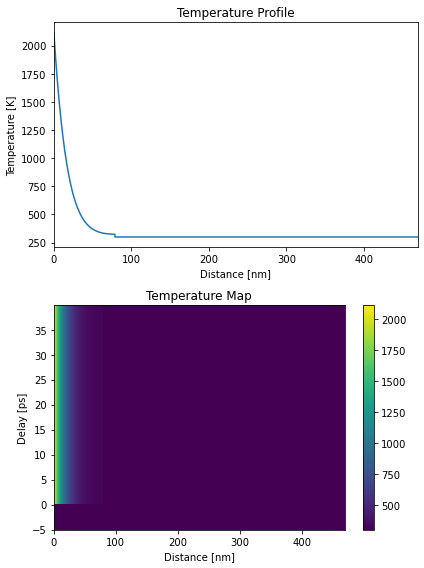
Numerical Phonons#
Refer to the phonons-example for more details.
p = ud.PhononNum(S, True)
p.save_data = False
p.disp_messages = True
strain_map = p.get_strain_map(delays, temp_map, delta_temp_map)
Calculating linear thermal expansion ...
Calculating coherent dynamics with ODE solver ...
Elapsed time for _strain_map_: 0.723023 s
plt.figure(figsize=[6, 8])
plt.subplot(2, 1, 1)
plt.plot(distances.to('nm').magnitude, strain_map[130, :], label=np.round(delays[130]))
plt.plot(distances.to('nm').magnitude, strain_map[350, :], label=np.round(delays[350]))
plt.xlim([0, distances.to('nm').magnitude[-1]])
plt.xlabel('Distance [nm]')
plt.ylabel('Strain')
plt.legend()
plt.title('Strain Profile')
plt.subplot(2, 1, 2)
plt.pcolormesh(distances.to('nm').magnitude, delays.to('ps').magnitude,
strain_map, cmap='RdBu', vmin=-np.max(strain_map),
vmax=np.max(strain_map), shading='auto')
plt.colorbar()
plt.xlabel('Distance [nm]')
plt.ylabel('Delay [ps]')
plt.title('Strain Map')
plt.tight_layout()
plt.show()
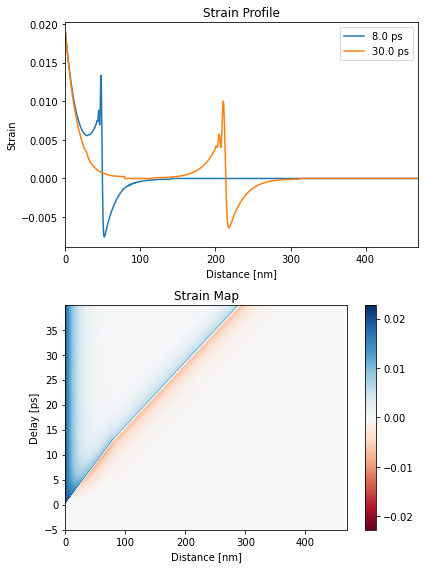
Initialize dynamical X-ray simulation#
The XrayDyn class requires a Structure object and a boolean force_recalc in order overwrite previous simulation results.
These results are saved in the cache_dir when save_data is enabled.
Printing simulation messages can be en-/disabled using disp_messages and progress bars can using the boolean switch progress_bar.
dyn = ud.XrayDyn(S, True)
dyn.disp_messages = True
dyn.save_data = False
incoming polarizations set to: sigma
analyzer polarizations set to: unpolarized
Homogeneous X-ray scattering#
For the case of homogeneously strained samples, the dynamical X-ray scattering simulations can be greatly simplified, which saves a lot of computational time.
\(q_z\)-scan#
The XrayDyn object requires an energy and scattering vector qz to run the simulations.
Both parameters can be arrays and the resulting reflectivity has a first dimension for the photon energy and the a second for the scattering vector.
dyn.energy = np.r_[5000, 8047]*u.eV # set two photon energies
dyn.qz = np.r_[3.1:3.3:0.00001]/u.angstrom # qz range
R_hom, A = dyn.homogeneous_reflectivity() # this is the actual calculation
Calculating _homogenous_reflectivity_ ...
Elapsed time for _homogenous_reflectivity_: 3.990309 s
plt.figure()
plt.semilogy(dyn.qz[0, :], R_hom[0, :], label='{}'.format(dyn.energy[0]), alpha=0.5)
plt.semilogy(dyn.qz[1, :], R_hom[1, :], label='{}'.format(dyn.energy[1]), alpha=0.5)
plt.ylabel('Reflectivity')
plt.xlabel('$q_z$ [nm$^{-1}$]')
plt.legend()
plt.show()
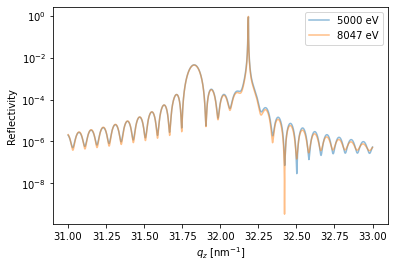
Due to the very thick static substrate in the structure and the very small step width in qz also the Darwin width of the substrate Bragg peak is nicely resolvable.
plt.figure()
plt.semilogy(dyn.qz[0, :], R_hom[0, :], label='{}'.format(dyn.energy[0]), alpha=0.5)
plt.semilogy(dyn.qz[1, :], R_hom[1, :], label='{}'.format(dyn.energy[1]), alpha=0.5)
plt.ylabel('Reflectivity')
plt.xlabel('$q_z$ [nm$^{-1}$]')
plt.xlim(32.17, 32.195)
plt.ylim(1e-3, 1)
plt.legend()
plt.title('Darwin Width')
plt.show()
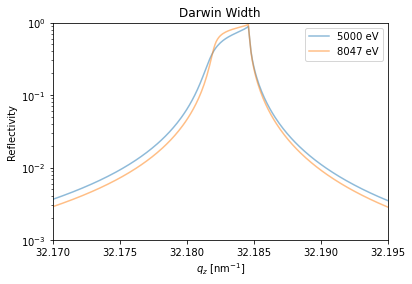
Post-Processing#
All result can be convoluted with an arbitrary function handle, which e.g. mimics the instrumental resolution.
FWHM = 0.004/1e-10 # Angstrom
sigma = FWHM/2.3548
handle = lambda x: np.exp(-((x)/sigma)**2/2)
y_conv = dyn.conv_with_function(R_hom[0, :], dyn._qz[0, :], handle)
plt.figure()
plt.semilogy(dyn.qz[0, :], R_hom[0, :], label='{}'.format(dyn.energy[0]))
plt.semilogy(dyn.qz[0, :], y_conv, label='{} convoluted'.format(dyn.energy[0]))
plt.ylabel('Reflectivity')
plt.xlabel('$q_z$ [nm$^{-1}$]')
plt.legend()
plt.show()
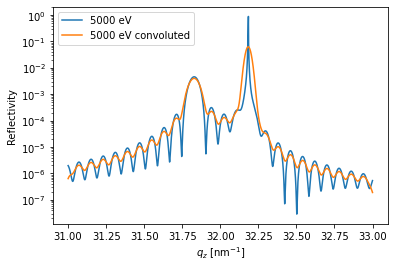
Energy-scan#
Energy scans rely on experimental atomic scattering factors that are include also energy ranges around relevant resonances.
The warning message can be safely ignored as it results from the former q_z range which cannot be accessed with the new energy range.
dyn.energy = np.r_[2250:3500]*u.eV # set the energy range
dyn.qz = np.r_[2]/u.angstrom # qz range
R_hom, A = dyn.homogeneous_reflectivity() # this is the actual calculation
plt.figure()
plt.plot(dyn.energy, R_hom[:, 0])
plt.ylabel('Reflectivity')
plt.xlabel('Energy [eV]')
plt.show()
c:\users\loc_schick\general\git\udkm1dsim\udkm1Dsim\simulations\xrays.py:239: RuntimeWarning: invalid value encountered in arcsin
self._theta = np.arcsin(np.outer(self._wl, self._qz[0, :])/np.pi/4)
Calculating _homogenous_reflectivity_ ...
Elapsed time for _homogenous_reflectivity_: 0.890771 s
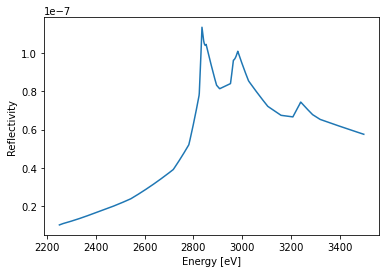
Inhomogeneous X-ray scattering#
The inhomogeneous_reflectivity() method allows to calculate the transient X-ray reflectivity according to a strain_map.
The actual strains per layer will be discretized and limited in order to save computational time using the strain_vectors.
dyn.energy = np.r_[8047]*u.eV # set two photon energies
dyn.qz = np.r_[3.1:3.3:0.001]/u.angstrom # qz range
strain_vectors = p.get_reduced_strains_per_unique_layer(strain_map)
R_seq = dyn.inhomogeneous_reflectivity(strain_map, strain_vectors, calc_type='sequential')
Calculating _inhomogeneousReflectivity_ ...
Calculate all _ref_trans_matrices_ ...
Elapsed time for _ref_trans_matrices_: 1.557266 s
Elapsed time for _inhomogeneous_reflectivity_: 45.179404 s
plt.figure()
plt.pcolormesh(dyn.qz[0, :].to('1/nm').magnitude, delays.to('ps').magnitude, np.log10(R_seq[:, 0, :]),
shading='auto')
plt.title('Dynamical X-ray')
plt.ylabel('Delay [ps]')
plt.xlabel('$q_z$ [nm$^{-1}$]')
plt.show()
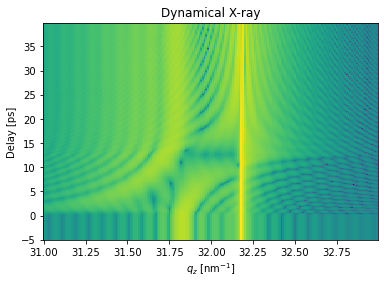
The results can be convoluted again to mimic real experimental resolution:
R_seq_conv = np.zeros_like(R_seq)
for i, delay in enumerate(delays):
R_seq_conv[i, 0, :] = dyn.conv_with_function(R_seq[i, 0, :], dyn._qz[0, :], handle)
plt.figure(figsize=[6, 8])
plt.subplot(2, 1, 1)
plt.semilogy(dyn.qz[0, :].to('1/nm'), R_seq_conv[0, 0, :], label=np.round(delays[0]))
plt.semilogy(dyn.qz[0, :].to('1/nm'), R_seq_conv[100, 0, :], label=np.round(delays[100]))
plt.semilogy(dyn.qz[0, :].to('1/nm'), R_seq_conv[-1, 0, :], label=np.round(delays[-1]))
plt.xlabel('$q_z$ [nm$^{-1}$]')
plt.ylabel('Reflectivity')
plt.legend()
plt.title('Dynamical X-ray Convoluted')
plt.subplot(2, 1, 2)
plt.pcolormesh(dyn.qz[0, :].to('1/nm').magnitude, delays.to('ps').magnitude,
np.log10(R_seq_conv[:, 0, :]), shading='auto')
plt.ylabel('Delay [ps]')
plt.xlabel('$q_z$ [nm$^{-1}$]')
plt.tight_layout()
plt.show()
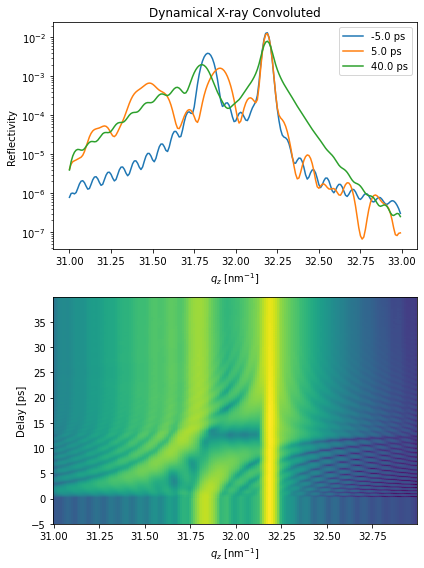
Parallel inhomogeneous X-ray scattering#
You need to install the udkm1Dsim with the parallel option which essentially add the Dask package to the requirements:
> pip install udkm1Dsim[parallel]
You can also install/add Dask manually, e.g. via pip:
> pip install dask
Please refer to the Dask documentation for more details on parallel computing in Python.
try:
from dask.distributed import Client
client = Client()
R_par = dyn.inhomogeneous_reflectivity(strain_map, strain_vectors, calc_type='parallel',
dask_client=client)
client.close()
except:
pass
Calculating _inhomogeneousReflectivity_ ...
Calculate all _ref_trans_matrices_ ...
Elapsed time for _ref_trans_matrices_: 2.199932 s
Elapsed time for _inhomogeneous_reflectivity_: 18.328078 s
plt.figure()
plt.pcolormesh(dyn.qz[0, :].to('1/nm').magnitude, delays.to('ps').magnitude,
np.log10(R_par[:, 0, :]), shading='auto')
plt.title('Parallel Dynamical X-ray')
plt.ylabel('Delay [ps]')
plt.xlabel('$q_z$ [nm$^{-1}$]')
plt.show()
